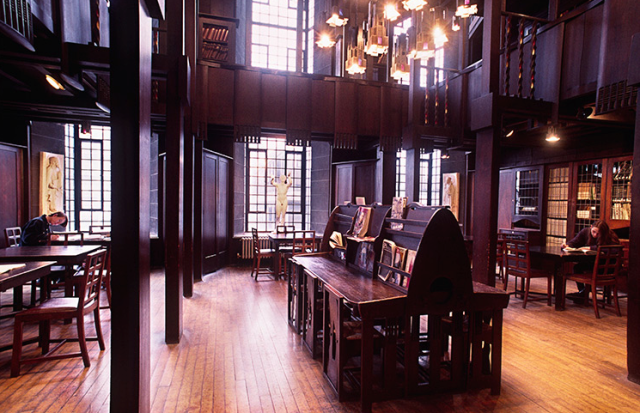
Macintosh Library at the Glasgow School of Art before fire. (historytoday.com)
Today is Charles Rennie Macintosh’s birthday, the 148th anniversary of his birth in 1868. Hats off to Joel Pidel and Paul Ranogajec for memorializing the event with the picture above. Paul also linked to an article in Archinect, “The architects trying to restore Macintosh’s library to its former glory,” by Robert Urquehart, about the restoration of the Glasgow School of Art, which was terribly damaged by fire a couple of years ago.
Architects and architectural historians debated whether to honor Macintosh by restoring his building – including especially the library, which was almost completely lost – as it had been or by casting about for a design that would reflect his stylistic sensibility in a contemporary manner. Fortunately, cooler heads prevailed and Park/Page Architects, a Glasgow firm very familiar with Macintosh, was hired to restore the building. Research required prior to the meticulous work of reconstruction is well under way, and has generated some remarkably interesting insights, as expressed in Archinect:
Is it really possible to recreate the work of a truly remarkable and visionary master-craftsman of the past? “On what we’ve learned so far, I think it would have to be realised that the interiors were perhaps not as finely honed as they appeared to be on the surface,” notes [GSA research fellow Dr. Robyne Erica] Calvert. “Any anxiety that we now lack the kind of craft skills that were employed to create the building is very clearly unfounded – the fire has revealed that while the surface of spaces like the library appeared highly hand-crafted, this was actually a well-designed façade, and the actuality is that the room was pieced together like ‘tea room shop fitting’, as Ranald MacInnes of Historic Environment Scotland so aptly put it.”
What does Dr. Calvert mean by this? “Nails were hammered wherever they were needed and finished surfaces covered up rough and readily available materials underneath. The space was not so precious in its construction, made in a workshop off-site and assembled in situ, almost like we might use ‘flat-pack’ material today,” she explained.
“We knew that a variety of local labour was used and that it wasn’t made with the idealised ‘Arts & Crafts’ approach that many assumed, but [the] beauty of the finished result belied this: seeing the evidence of all of it first-hand was still somehow surprising. It has given us an opportunity to reflect on Mackintosh and his working methods, and the way in which his mastery was about creating the ‘look’ of space in a manner that left one feeling every detail was finely wrought, when the reality ‘under the surface’ tells a much different story.”
Wow. This reveals the magic of Macintosh’s work, and by extension the work of every architect/craftsman whose imaginative design is built by artisans who put their personal stamp to some degree on the personal stamp of the architect – yet do so in an off-hand manner that suggests the impossibility of gaining the same result via the sort of mechanized system of which modernists are so enamored.
Happy birthday, Mac!



Nice blog,
I learned more about Mr.mac and am wishing him my belated wishes for his b’day!
LikeLike
Among modernist architects and their sympathizers, there is a persistent sense that “we can’t do today what they did years ago” and so we are told that restoration and reconstruction is not only “false,” but cannot possibly do justice to the craftsmanship of the past. Of course, some highly artistic work of the past would be hard to match, but by no means all, and particularly not once one crosses into the industrial age. As Henry Hope Reed marvelously said, “What human beings have done once, they can do again.” Yes, and maybe if people stopped denying that the beautiful work of the past can be matched today, we might see a lot more of it being done.
LikeLike
Hear, hear!!!
LikeLike
Precisely. Today, we can repair the damage to the ornate ceiling of the main reading room in the New York Public Library, equaling the original craft. Check out my friend (and fellow RISD grad) Eric Hammarberg explaining the work here: http://www.nypl.org/help/about-nypl/capital-projects/rose-main-reading-room
Our main problem is that the advent of “modernism” drove the majority of the craftsmen out of business, so the pipeline of apprentices dried up almost completely. Fortunately, the skills aren’t completely lost.
LikeLike
Too bad the fire didn’t happen in the building across the street….http://www.dezeen.com/2014/03/06/glasgow-school-of-art-reid-building-steven-holl/
LikeLike